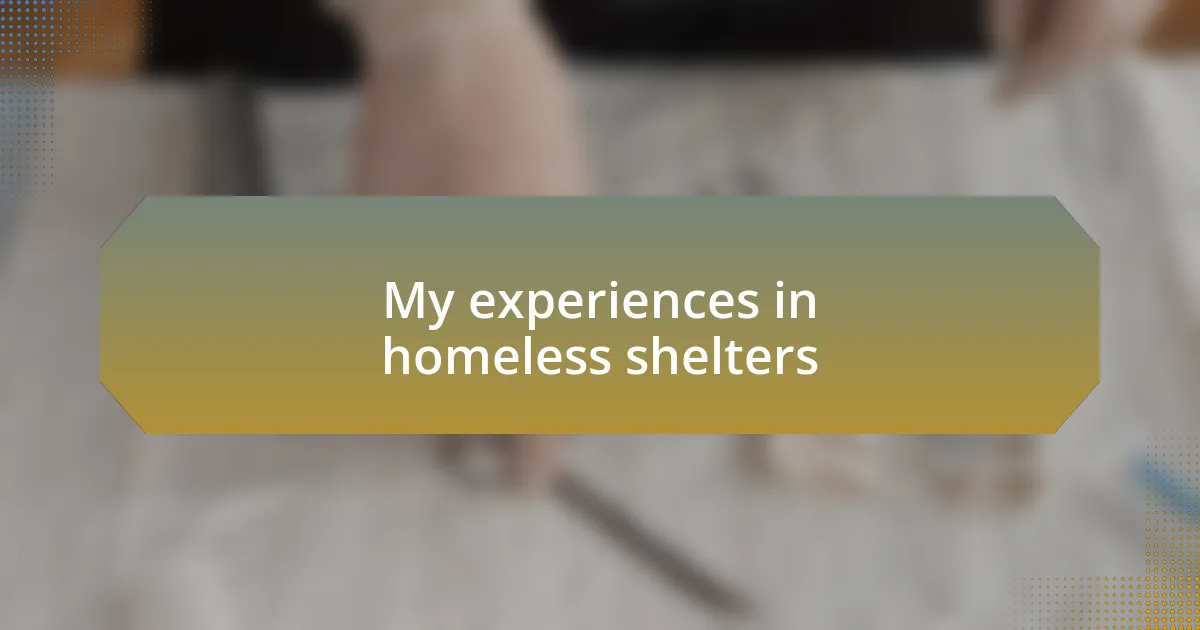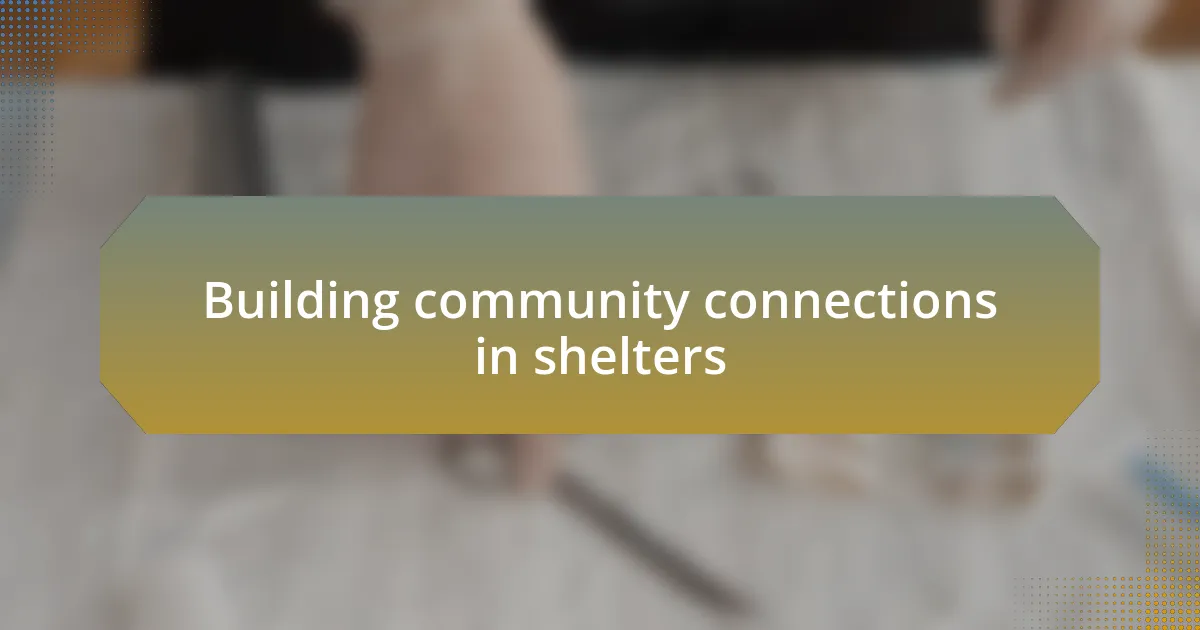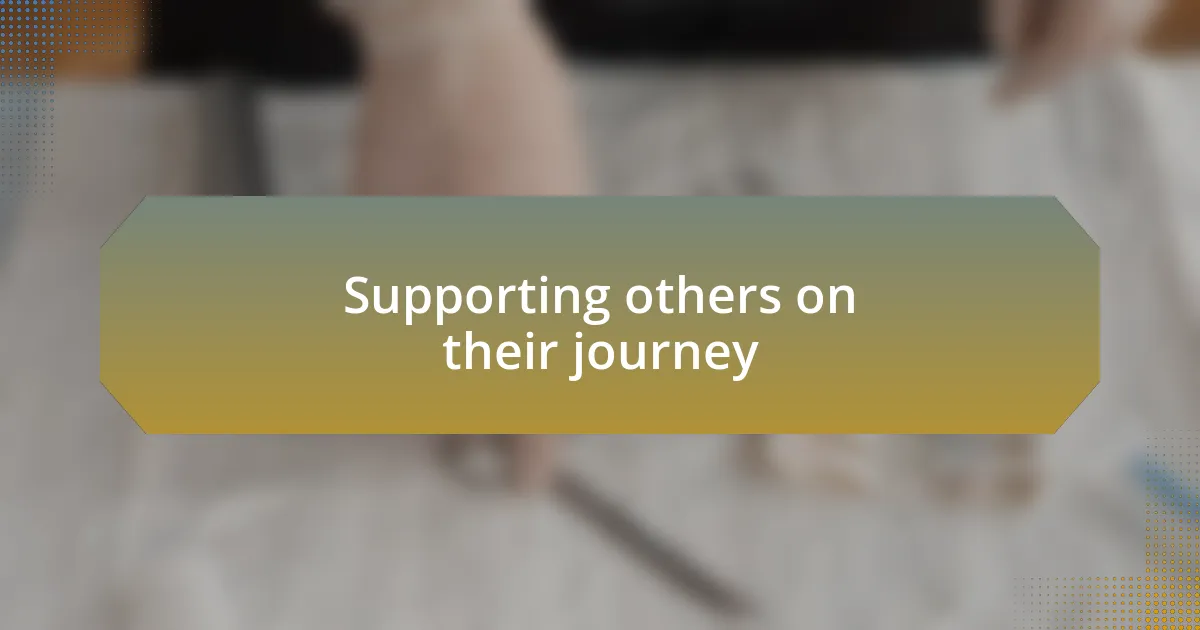Key takeaways:
- Financial instability, mental health issues, and addiction are major contributors to homelessness, often stemming from unexpected life events.
- Building community connections in shelters through shared activities fosters resilience and a sense of belonging among residents.
- Sharing personal stories serves as a source of strength and healing, creating deep connections and promoting mutual understanding among individuals facing hardship.
- Providing support, whether through active listening or mentorship programs, empowers individuals on their journey toward recovery and personal growth.

Understanding homelessness and its causes
Homelessness isn’t just a lack of a roof over one’s head; it often stems from a complex web of factors. During my volunteer days, I met Sarah, a single mother whose eviction followed a sudden job loss. It made me wonder—how many others face similar circumstances, where a single event spirals into a life-altering crisis?
Financial instability is a common thread in many stories of homelessness. I recall sitting with a gentleman in a shelter who shared how a medical emergency wiped out his savings in an instant. It struck me that unexpected expenses can happen to anyone. How do we ensure that our safety nets catch the most vulnerable among us when life takes an unexpected turn?
Mental health issues and addiction are often intertwined with homelessness, yet society tends to overlook these struggles. I remember conversing with Jake, a talented artist, who felt trapped in a cycle of isolation and substance use. His story made me reflect: how can we shift perceptions about those facing such challenges, and foster a more compassionate response to their plight?

My experiences in homeless shelters
My time in homeless shelters opened my eyes to the profound depth of human experience. I remember a cold night, huddled on a cot and glancing around the dimly lit room. Everyone was wrapped in their own silence, but beneath the surface, I could sense a tapestry of dreams, fears, and untold stories. How could something so transient hold so much weight?
One evening, a woman named Lisa shared her story about being separated from her family due to domestic violence. Her voice trembled as she recounted her journey to safety, filled with heartbreak yet marked by a fierce will to rebuild her life. I wondered, how many other women share similar battles? The strength of those I met was a raw reminder of resilience—an ember flickering in the darkest of times.
I also saw compassion bloom in the most unexpected places. During a shared meal, a young man named Alex offered his last granola bar to someone who looked worried and hungry. It made me think: what drives one to share when they have so little? Those moments of kindness transformed the shelter into a community, reminding us that even in hardship, there is room for care and connection. It prompted me to consider how crucial it is to nurture that sense of belonging amidst the challenges.

Building community connections in shelters
Building community connections in shelters is often a subtle but powerful experience. I remember a time when a group of us started a small book exchange. Initially, it seemed like a simple act, but it quickly became a bridge for conversations. One evening, while sharing our favorite titles, I noticed how a shared passion for stories transformed strangers into friends, making the nights warmer and less isolating. Isn’t it fascinating how a single book can ignite discussions about dreams and aspirations?
Social gatherings, even those as modest as game nights, revealed the strength of communal bonds. I vividly recall a night when we played cards under the flickering lights, laughter echoing off the walls. In those moments, the challenges we faced faded, replaced by camaraderie and joy. This connection fostered an environment where everyone could feel seen and heard. It made me reflect: what if such simple activities could ignite hope and resilience in those feeling lost?
Volunteering within the shelter also opened my eyes to the significance of community ties. I took part in organizing a workshop where we shared skills like cooking and budgeting. Witnessing attendees teach each other was immensely rewarding; it illustrated how sharing knowledge cultivates self-worth. How could we not thrive when surrounded by individuals who uplift one another? Seeing people grow together solidified my belief that connection is crucial in the journey toward rebuilding lives.

Overcoming challenges through personal stories
Sharing personal stories in shelters often becomes a source of strength and healing. I recall a poignant moment when I listened to a fellow resident recount her journey through addiction. As she spoke, her vulnerability drew us all in, and I realized that her story wasn’t just about hardship; it was about resilience and transformation. How many people are willing to share their struggles if it means creating bonds that can inspire hope in others?
There was another time when I decided to share my own experience of losing my home. Sitting in a circle, I felt the weight of my emotions but pushed through because I knew others needed to hear that they weren’t alone. The response was overwhelming—people nodded in understanding, reflecting their own fears and triumphs back at me. In that moment, I understood that our stories have the power to connect us deeply, even in the most challenging circumstances.
Additionally, I’ve noticed how storytelling can help reclaim dignity. Just last month, a group of us organized an open mic night where anyone could share their journey. When one man stepped up, his hands trembling, he spoke of survival against all odds. His heartfelt words silenced the room, and for a brief moment, we all shared a common humanity. Isn’t it incredible how sharing our truths helps not only the speaker but also everyone listening?

Supporting others on their journey
Supporting someone on their journey can be as simple as offering a listening ear. I remember one evening, after a long day at the shelter, I noticed a newcomer sitting alone, visibly upset. I approached her and asked if she wanted to talk. To my surprise, she opened up about her struggles and fears, and in that moment, I realized that sometimes, just being present for another person can make a world of difference.
When we create a supportive environment, it encourages others to share their own stories. I once joined a small support group where everyone was invited to express their feelings, no matter how difficult. As I listened to others voice their fears, I felt a mutual understanding grow. It’s fascinating how our shared experiences can transform the atmosphere—suddenly, we were no longer individuals facing separate battles, but a collective force of resilience working towards healing.
I’ve also found that practical support can be just as impactful. A few weeks ago, I helped organize a mentorship program connecting residents with volunteers from the community. Seeing those relationships flourish was heartwarming. It underscored the idea that by supporting each other, we pave the way for personal growth and empower one another to navigate our journeys. After all, isn’t it true that everyone benefits when we lift each other up?